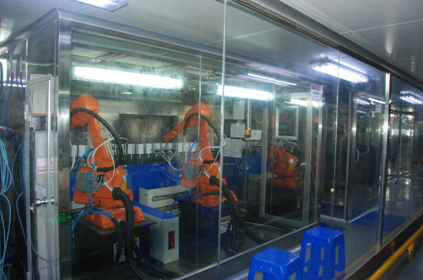

 |
| Robots with intelligent sensors glazing cellphone cases. These machines have helped to save 60 percent of the paint. (People's Daily Online/Fu Changchao) |
"World factory" Dongguan is now experiencing a wave of machines replacing people. In 2014, statistics showed that 66 percent of 441 enterprises were using machines to replace workers, and 92 percent of enterprises interviewed confirmed that they would be expanding the number of machines in the next two years.
What advantages will this project bring to the companies involved? And are there any problems during the transfer?
Active creativity is the foundation for the development of any enterprise. To reduce costs, open new markets, and increase profit by relying on technical progress is becoming the choice of more and more companies. For cities like Dongguan, where labor-intensive industries gather, using machines to replace the labor force has been beneficial for many: companies become more efficient and profitable; their costs are reduced and competitiveness improves. Taking a knitwear mill as an example, it used to take one worker to control each machine during the production process, but now with the introduction of high-tech machines, one worker can control 8 fully-automatic computer-controlled facilities at the same time.
Though the project of replacing people with machines has made some progress, it is still necessary to direct attention to China's bottlenecks in technology, capital, and talent.
First of all, domestic capabilities in the production of high-end intelligent equipment are still insufficient. The machines that companies have introduced have mostly been imported from abroad. "We really want to use some domestic robots and machines," said a manager of a manufacturing company. "But imported equipment is more stable and accurate in production even though domestic products are very tempting in price."
Second, professional technicians and researchers are also in short supply domestically. With the import of more high-tech machines, more professional technicians and researchers are also needed in the market. And the costs of "replacing people with machines" have consequently increased in part.
Moreover, to fully accomplish a project requires a great amount of investment, and it takes 2, 3 years or even longer to recover the costs. Should a market fall and orders dry up, a company can find itself with idle capacity. That risks trapping it in a vicious circle.
As a result, business should avoid blindly following suit in this replacement project, but comprehensively consider capabilities, capital, market, technical support, and other basic management factors before making any decision.
This article is edited and translated from 《东莞:“世界工厂”的“机器换人”之路》,source: People's Daily Online, author: Fu Changchao, Zhang Xiaohe
 J-11 fighters in air exercise
J-11 fighters in air exercise Beauties dancing on the rings
Beauties dancing on the rings Attendants-to-be join Mr. & Miss Campus Contest
Attendants-to-be join Mr. & Miss Campus Contest Beijing's toughest anti-smoking law takes effect
Beijing's toughest anti-smoking law takes effect Family lives in cave for about 50 years in SW China
Family lives in cave for about 50 years in SW China PLA soldiers operating vehicle-mounted guns in drill
PLA soldiers operating vehicle-mounted guns in drill Blind carpenter in E China's Jiangxi
Blind carpenter in E China's Jiangxi China hosts overseas disaster relief exercise for the first time
China hosts overseas disaster relief exercise for the first time 20 pairs of twins who will become flight attendants in Sichuan
20 pairs of twins who will become flight attendants in Sichuan Obama is sowing discontent in S.China Sea
Obama is sowing discontent in S.China Sea Rescuers work through night to reach cruise ship survivors
Rescuers work through night to reach cruise ship survivors Driving through limbo
Driving through limbo Facing down MERS
Facing down MERSDay|Week